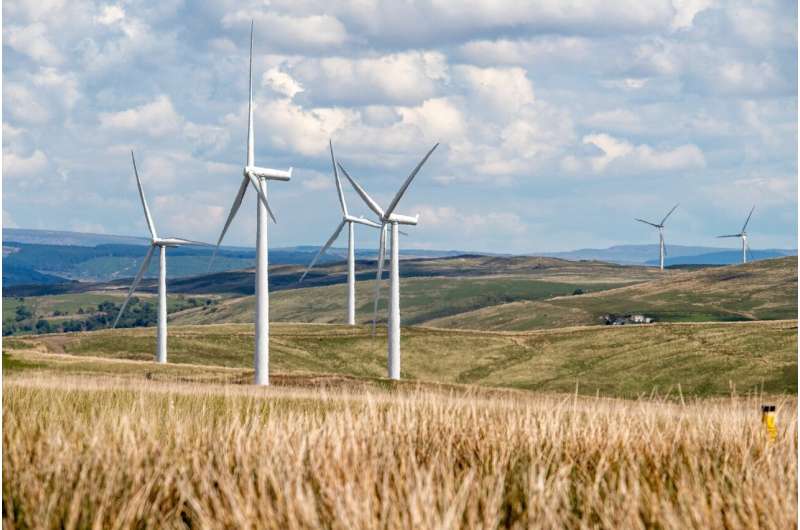Image source: Pixabay/CC0 Public Domain
The transition from a high-carbon sustainable energy system to a low-carbon sustainable energy system requires many milestones. The first hour has no coal, oil, or gas generation (or all of them together), and the last coal, oil, or gas power plant (or all of them together) is eventually retired.
Another important milestone is the first year that renewable energy generates more electricity than fossil fuels. We have been tracking data from the UK (not Northern Ireland, which shares the grid with the Republic of Ireland) for the past three months and we believe the UK is expected to surpass this milestone in 2023, but it will be very close.
By the broadest definition, renewable energy actually overtook fossil fuels for the first time in the weird COVID-19 year of 2020 (though not in the subsequent 2021 and 2022 years). However, this includes around 5% of the UK’s electricity being generated through “biomass” plants (burning wood pellets, often imported from US forests).
Trees can of course regrow, so biomass counts as a renewable energy source. But the industry also has its critics, and it doesn’t scale as globally as “weather-dependent” renewable energy sources (wind, solar and to some extent hydropower).
When we use this narrower, weather-dependent definition that better suits the global transition, there is a good chance that these renewable energy sources will overtake fossil fuels for the first time in 2023. Once this milestone is passed, we also think it is unlikely (although not impossible) that gas and coal will again overtake wind, solar and hydro in UK full-year electricity generation.
Whether the UK reaches this milestone in 2023 will depend on the final days of the year (from now on we will use “renewable energy” to refer to a stricter definition that excludes biomass).
The chart above can be used to track progress and will be updated daily with the latest data. The lines show the sum of the differences between renewable and fossil fuel power generation.
When the line increases, it indicates that there was more renewable energy than fossil fuels during that period. The horizontal axis shows the day of the year, so if at any point the line is above the zero axis, it indicates that more electricity has been generated from renewable energy than from fossil fuels so far that year. The UK will achieve the milestone if the red line ends the year above zero.
(It’s important to note that we know from official statistics released later that there are some discrepancies in the “absence” of embedded power generation and estimates; this typically amounts to only about 1%-2% of the final total.)
Depends on weather
As we write this, with 10 days of data left in 2023, renewables are slightly ahead (just over 1,000 GWh, the same level as on peak electricity demand days). However, if they are to stay ahead, it will depend on the weather, especially the wind.
The reason here is that the UK uses less electricity during the holidays due to reduced industrial and commercial demand. Because wind power is cleaner and becomes cheaper, it tends to be used first, meaning that when demand is lower or winds are strong enough, there is less need to use fossil fuels to generate electricity.
There are some nuances, such as where electricity is generated and how much power is imported from other countries, but the general principle that renewables take market share away from fossil fuels is a factor in the UK electricity market.
An important area that also needs to be highlighted is the continued decline in electricity demand. Demand in 2023 is expected to be lower than in 2022, which is also lower than in the COVID-19-affected 2020 (contrary to our forecast) due to record prices. Falling demand for electricity means there is no need for additional generation, much of which inevitably comes from fossil fuels.
Another milestone may also be surpassed
However, 2023 may be the first year that renewable energy generation exceeds domestic electricity demand (household electricity demand accounts for 36% of total electricity demand). This means that the UK’s wind turbines, solar panels and hydro resources will generate more electricity each year than its 29 million homes consume throughout the year.
The bar chart above shows trends since 2009. In the first half of 2023, renewable energy generation fell 1.5 TWh (1,500 GWh) below domestic electricity demand, but strong renewable energy performance since then means total generation is likely to exceed household demand by the end of the year.
If any of the milestones described here are not achieved in 2023, they will almost certainly be achieved in 2024, during which time a further 1.7 GW of offshore wind capacity will begin generating electricity and the UK’s last coal-fired power station is planned to be fully Stop generating electricity.
provided by The Conversation
This article is republished from The Conversation under a Creative Commons license. Read the original article.![]()
citation: UK wind, solar and hydro generation could exceed fossil fuel generation for first time in 2023 (December 22, 2023), Retrieved December 23, 2023, from https://techxplore.com/news/2023-12-britain -generate electricity solar hydroelectricity.html
This document is protected by copyright. No part may be reproduced without written permission except in the interests of fair dealing for private study or research purposes. Content is for reference only.
#wind #solar #hydro #generation #exceed #fossil #fuel #generation #time
Image Source : techxplore.com
